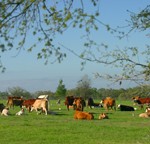 Beef replacement heifers are a necessary but costly part of every cow-calf operation. A decision needs to be made to either purchase replacement heifers or raise them on the ranch. This is a long-term decision that will affect the ranch for many years through the genetics of the replacement heifers and through equipment and management inputs. This 9-page fact sheet provides an analysis of considerations for raising replacements; factors to consider in selection; and recommendations for nutritional management. Written by Phillip Lancaster, Chris Prevatt, and John Arthington, and published by the UF Department of Animal Sciences, March 2015. (Photo: Beef Improvement Federation)
Beef replacement heifers are a necessary but costly part of every cow-calf operation. A decision needs to be made to either purchase replacement heifers or raise them on the ranch. This is a long-term decision that will affect the ranch for many years through the genetics of the replacement heifers and through equipment and management inputs. This 9-page fact sheet provides an analysis of considerations for raising replacements; factors to consider in selection; and recommendations for nutritional management. Written by Phillip Lancaster, Chris Prevatt, and John Arthington, and published by the UF Department of Animal Sciences, March 2015. (Photo: Beef Improvement Federation)
http://edis.ifas.ufl.edu/an132
Tag: John D. Arthington
Environmental Impact of Beef Cattle Production Systems
 This 6-page fact sheet discusses beef demand in the context of a growing population, beef production’s greenhouse gases and their effect on the environment, the great advantage of ruminants, generating accurate greenhouse gas emissions estimates, greenhouse gas emissions by economic sector, and mitigation strategies. Written by Nicolas DiLorenzo, G. Cliff Lamb, Jose Dubeux, John Arthington, Joao Vendramini, and Phillip Lancaster and published by the UF/IFAS Department of Animal Sciences, November 2014. (UF/IFAS Photo by Thomas Wright)
This 6-page fact sheet discusses beef demand in the context of a growing population, beef production’s greenhouse gases and their effect on the environment, the great advantage of ruminants, generating accurate greenhouse gas emissions estimates, greenhouse gas emissions by economic sector, and mitigation strategies. Written by Nicolas DiLorenzo, G. Cliff Lamb, Jose Dubeux, John Arthington, Joao Vendramini, and Phillip Lancaster and published by the UF/IFAS Department of Animal Sciences, November 2014. (UF/IFAS Photo by Thomas Wright)
http://edis.ifas.ufl.edu/an302
Cow Math: Using Weaning Weight to Estimate Cowherd Productivity
 “You can’t get where you’re going unless you know where you are.”
“You can’t get where you’re going unless you know where you are.”
The ability to measure performance is a key component in all beef cow operations, and measuring production efficiency is becoming increasingly important. Regardless of size, producers must be able to identify the current status of their operation in order to make adjustments toward improvement. Identifying and culling the cows within the herd that are less efficient at producing a weaned calf in the environment and management system used on the ranch can be a powerful tool to improve the herd. This 8-page fact sheet was written by Phillip Lancaster and John Arthington, and published by the UF Department of Animal Science, April 2014.
http://edis.ifas.ufl.edu/an129
SSAGR63/AA192 Forage Testing
Revised! SS-AGR-192, a 4-page fact sheet by J.M. Vendramini, M.S. Silveira, J. D. Arthington, and A. R. Blount, provides basic information about forage testing procedures at the UF/IFAS Forage Extension Testing Laboratory, where to send samples, how to interpret the testing results and how to collect a sample. Includes references. Published by the UF Department of Agronomy, February 2009.
http://edis.ifas.ufl.edu/AA192
AN086/AN086 Essential Trace Minerals for Grazing Cattle in Florida
Revised! AN086, an 8-page fact sheet by John D. Arthington, reviews trace minerals that are recognized as deficient in Florida grazing cattle and that are important considerations in supplementation programs, supplementation, and analysis of herd trace mineral status. Published by the UF Department of Animal Science, May 2008.